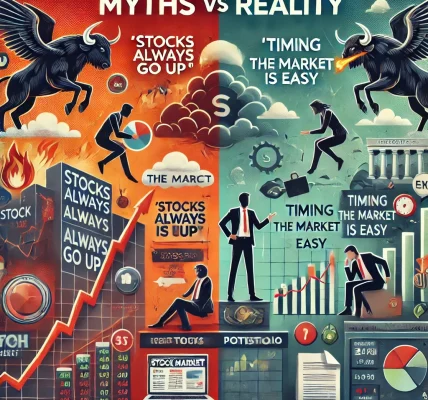Introduction
The stock market operates on a standard trading schedule, but activity doesn’t stop when the closing bell rings. Many investors participate in pre-market and after-hours trading, which occur outside the regular trading hours. These extended trading sessions can significantly impact stock prices and market trends, offering opportunities and risks for traders.
In this article, we will explore what pre-market and after-hours trading are, how they work, their advantages and challenges, and their overall influence on stock prices.
What is Pre-Market and After-Hours Trading?
Pre-Market Trading
Pre-market trading occurs before the stock market officially opens. In the U.S., pre-market trading typically runs from 4:00 AM to 9:30 AM EST. During this period, traders react to overnight news, earnings reports, and global market developments.
After-Hours Trading
After-hours trading takes place after the market closes, from 4:00 PM to 8:00 PM EST. It allows investors to react to late-breaking news, earnings reports, and economic events that happen after regular trading hours.
Both pre-market and after-hours trading occur on electronic communication networks (ECNs) rather than traditional stock exchanges, meaning liquidity and trading volumes can differ significantly.
Why Do Investors Trade Outside Regular Hours?
1. Reaction to News and Earnings Reports
Many companies release quarterly earnings reports after the market closes. Investors trade in the after-hours session to immediately react to financial results, driving sharp price movements.
2. Global Market Influences
Markets in Asia and Europe operate at different times, influencing U.S. stocks overnight. Traders use pre-market sessions to adjust positions based on global market trends and macroeconomic developments.
3. Economic Data Releases
Key economic reports, such as GDP growth, unemployment rates, and inflation data, are often published before the market opens. Pre-market trading allows investors to adjust their strategies accordingly.
4. Hedging and Institutional Strategies
Institutional investors and hedge funds use extended trading hours to hedge positions, manage risks, and take advantage of opportunities not available during standard hours.
How Pre-Market and After-Hours Trading Affect Stock Prices
1. Increased Volatility
Stock prices can experience dramatic fluctuations in extended trading hours due to lower trading volume and limited liquidity. A single large order can cause a stock price to spike or drop significantly.
2. Price Gaps Between Sessions
Stocks often open at a different price than their previous closing price, known as a price gap. This occurs when significant news or events influence investor sentiment before regular trading begins.
3. Limited Liquidity
Fewer participants trade in extended sessions, meaning it can be harder to buy or sell shares at desired prices. Wider bid-ask spreads make trading riskier.
4. False Signals and Overreactions
Retail traders sometimes overreact to news during pre-market or after-hours trading, causing temporary spikes or drops. When regular trading resumes, stock prices often stabilize as institutional investors step in.
5. Influence on Market Open and Close
Strong pre-market activity can set the tone for the trading day, influencing how stocks open. Similarly, heavy after-hours trading can dictate how a stock will behave in the following session.
Risks and Challenges of Pre-Market and After-Hours Trading
1. Higher Volatility and Risk
The lack of liquidity makes stocks more volatile, leading to larger price swings and higher risk for traders.
2. Limited Participation
Not all investors have access to pre-market and after-hours trading. Some brokerage firms restrict trading hours, limiting opportunities.
3. Execution Challenges
Orders placed in extended hours may not always be filled at expected prices due to wider bid-ask spreads and low trading volume.
4. Market Manipulation
Smaller trading volumes make it easier for large traders or institutions to manipulate stock prices, misleading retail investors.
5. Lack of Regulation
Regulatory protections in pre-market and after-hours trading are not as strong as during regular sessions, increasing potential risks for investors.
Who Should Trade in Pre-Market and After-Hours Sessions?
Best-Suited for Experienced Traders
- Day traders looking to capitalize on price swings.
- Institutional investors hedging positions.
- Investors reacting to earnings reports or breaking news.
Not Ideal for Casual Investors
- Those who prefer stability and lower risk.
- Investors unfamiliar with after-hours trading mechanics.
- Traders who rely on high liquidity and tighter spreads.
Tips for Trading in Extended Hours
- Use Limit Orders: Avoid market orders, as price fluctuations can be extreme.
- Watch Pre-Market and After-Hours Trends: Analyze extended trading sessions before making decisions.
- Consider Liquidity: If trading volume is too low, execution may be difficult.
- Stay Updated on News: Economic reports and earnings releases drive price movements.
- Understand Brokerage Restrictions: Not all brokers allow full extended-hours trading.
Conclusion
Pre-market and after-hours trading provide investors with unique opportunities to react to news and market-moving events outside regular hours. However, these sessions come with increased risks, including high volatility, low liquidity, and execution challenges.
Investors should approach extended trading with caution, using strategies like limit orders, risk management, and thorough market analysis. While these sessions are valuable for active traders, long-term investors should focus on regular market hours where liquidity and price stability are greater.




